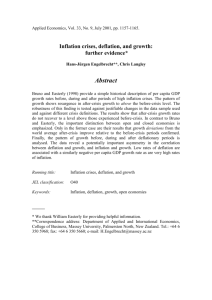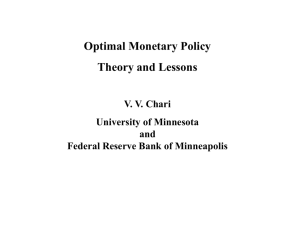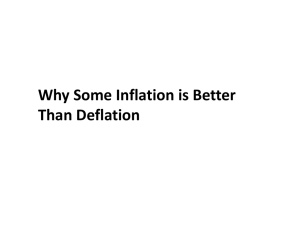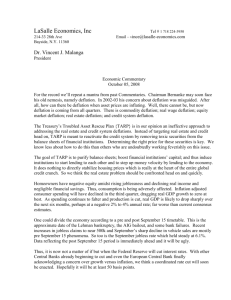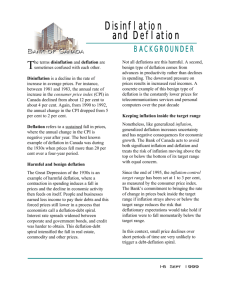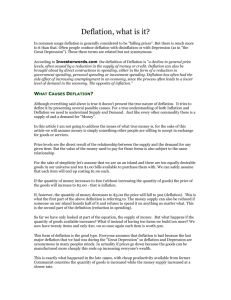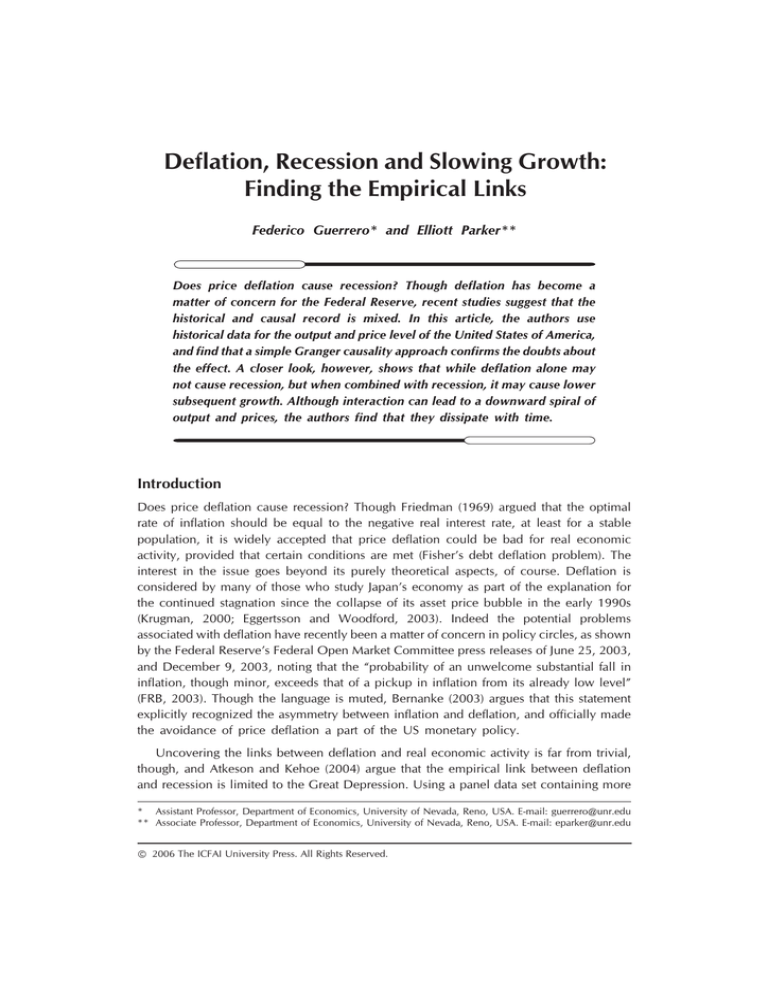
Deflation, Recession and Slowing Growth:
Finding the Empirical Links
Federico Guerrero* and Elliott Parker**
Does price deflation cause recession? Though deflation has become a
matter of concern for the Federal Reserve, recent studies suggest that the
historical and causal record is mixed. In this article, the authors use
historical data for the output and price level of the United States of America,
and find that a simple Granger causality approach confirms the doubts about
the effect. A closer look, however, shows that while deflation alone may
not cause recession, but when combined with recession, it may cause lower
subsequent growth. Although interaction can lead to a downward spiral of
output and prices, the authors find that they dissipate with time.
Introduction
Does price deflation cause recession? Though Friedman (1969) argued that the optimal
rate of inflation should be equal to the negative real interest rate, at least for a stable
population, it is widely accepted that price deflation could be bad for real economic
activity, provided that certain conditions are met (Fisher’s debt deflation problem). The
interest in the issue goes beyond its purely theoretical aspects, of course. Deflation is
considered by many of those who study Japan’s economy as part of the explanation for
the continued stagnation since the collapse of its asset price bubble in the early 1990s
(Krugman, 2000; Eggertsson and Woodford, 2003). Indeed the potential problems
associated with deflation have recently been a matter of concern in policy circles, as shown
by the Federal Reserve’s Federal Open Market Committee press releases of June 25, 2003,
and December 9, 2003, noting that the “probability of an unwelcome substantial fall in
inflation, though minor, exceeds that of a pickup in inflation from its already low level”
(FRB, 2003). Though the language is muted, Bernanke (2003) argues that this statement
explicitly recognized the asymmetry between inflation and deflation, and officially made
the avoidance of price deflation a part of the US monetary policy.
Uncovering the links between deflation and real economic activity is far from trivial,
though, and Atkeson and Kehoe (2004) argue that the empirical link between deflation
and recession is limited to the Great Depression. Using a panel data set containing more
* Assistant Professor, Department of Economics, University of Nevada, Reno, USA. E-mail: guerrero@unr.edu
** Associate Professor, Department of Economics, University of Nevada, Reno, USA. E-mail: eparker@unr.edu
©
2006 The ICFAI University Press. All Rights Reserved.
Deflation, Recession, and Slowing Growth: Finding the Empirical Links
37
than a century of annual observations of price inflation and GDP growth for 17 countries,
they examine five-year increments and found little correlation between the two, except
during the 1929-1933 period. Even then, they found that while all economies in their
sample experienced negative growth, only half experienced deflation, and while the
slope coefficient in a regression of growth on inflation was 0.4 for that period (i.e., a
1% deflation rate was associated with a 0.4% reduction in the growth rate), the t-statistic
was not very high even then.
Yet, an alternative interpretation of Atkeson and Kehoe’s results is that deflations may
be bad only under certain circumstances, and this is the line of inquiry this paper pursues.
We first review why deflation could have asymmetric effects on the economy, i.e., price
deflation might cause recession even though price inflation does not cause growth, and
low rates of deflation might have substantially different effects than low rates of inflation.
We then examine an annual data set of approximately two centuries of output growth
and price level changes for the case of the United States. After examining issues of
stationarity and Granger Causality, we confirm the overall result of Atkeson and Kehoe
(2004) that price deflation does not, in general, cause recession, though not surprisingly,
recessions may cause deflation. We then consider the causal effect in more detail, and
find evidence that price deflations that occur together with recessions can reduce
subsequent growth. This effect eventually disappears, since real output and price level
do not share a long run equilibrium relationship. However, this article finds that it takes
two or more years for the negative effects of deflation on subsequent real output growth
to be eliminated, thus providing a reduced-form justification for policymakers’ concerns
about the potentially disruptive effects of deflation on real economic activity.
The Economic Effects of Price Deflation
Why would a decrease in the overall price level adversely affect the economy? Most basic
macroeconomic models focus on the role of the price level in clearing output markets,
so that a decrease in aggregate demand should lead to a fall in the price level, but this
deflation in turn should lead to rising output as the real value of money holdings increases.
That is, recession may cause deflation (or at least disinflation), but deflation should in turn
be expansionary in the presence of the well-known real balances effect.
However, there are several reasons why under certain conditions deflation can reduce
economic growth in the short to medium term, as Eggertsson and Woodford (2003) and
Cargill and Parker (2003), among others, point out. The effects of inflation and deflation
may further be asymmetric: low rates of deflation may have effects similar in magnitude
to much higher rates of inflation, as Taylor (2001) finds for Japan, and Engelbrecht and
Langley (2001) uncover for a larger sample of countries. The effects of deflation are largely
connected to the effect of deflation on real interest rates due to the nominal rate’s zero
lower bound. As currency yields a nominal rate of zero, it becomes impossible for bonds
and loans, which must include a risk premium, to pay a non-positive return without an
explicit tax on currency holdings. Deflation leads to a real rate of interest in excess of
the nominal rate, and if deflation rates are high enough then the real interest rate rises.
38
The ICFAI Journal of Monetary Economics, February 2006
The first effect of deflation is Fisher’s (1933) debt-deflation connection, as unexpected
price deflation raises the cost of debt repayment. When deflation is combined with
recession, this can lead to an increased rate of default by firms and other borrowers, with
predictable results on the financial system. Second, the expectation of further deflation
may increase real money demand because it creates a positive real return on currency
and deposits. Indeed, Cargill and Parker (2004a) compare the evidence for the United States
during the Great Depression, and both Japan and China during the last decade, and find
that in addition to the expected effect of changing nominal interest rates, deflation had
an asymmetric effect on money demand in both the United States and Japan, though not
for China. Third, expected deflation can decrease current consumption in anticipation,
a relationship that is consistent with the hypothesis that deflation increases real money
demand,1 and Cargill and Parker (2004b) find some evidence supporting this hypothesis
for Japan.
Finally, price deflation appears to lead to a fall in the deposit expansion multiplier.
As the nominal interest rate approaches zero, the risk premium for bank lending over
government bonds is compressed. In Japan, banks have moved a significant fraction of
their portfolio from loans to government bonds, and the net result has sometimes been
interpreted as generating a discontinuity in monetary policy, popularly known as the
‘liquidity trap’.2 Though widely understood as implying that monetary policy would
become impotent in a severe recession, this discontinuity may instead be considered a
reason to believe that monetary policy becomes less effective unless monetary authorities
are able to eliminate medium-term expectations of deflation. As a deflation continues,
the amount of expansion in the monetary base needed to generate anticipations of price
inflation also increases, and these expectations may display a certain inertia. If correct,
this interpretation implies that Japan’s monetary policy of zero nominal interest rates was
bound to be ineffective (as argued, among others by Eggertsson and Woodford, 2003; and
Ito and Mishkin, 2004), because it was an explicitly temporary effort, and could have better
been replaced with a policy of price level targeting.
Thus, we can argue that deflation would ‘cause’ recession only in a specific set of cases,
in which particular shocks within a particular environment combine with poor monetary
policy to create a tragic result. Only under those circumstances could deflation set off
a downward economic spiral.
The historical record on this issue is a complex one. In a broad review of worldwide
deflation during the past two centuries, Borio and Filardo (2004:7) argue that deflationary
periods may be grouped into three types: “the good, the bad and the ugly.” Good deflations
could result from productivity improvements, bad deflations could result from nominal
price rigidities, and ugly deflations could be those rare cases where self-reinforcing price
deflation spirals out of control. Both approaches are conceptually useful, but, as Bordo and
1
2
In a standard representative agent framework where both money and consumption are arguments in the
utility function, the assumption that the cross partial derivative of the utility function with respect to money
and consumption is positive, guarantees this result.
Meltzer (1999) disputes the existence of a liquidity trap in the recent Japanese experience.
Deflation, Recession, and Slowing Growth: Finding the Empirical Links
39
Redish (2003) note, from the empirical economist’s standpoint deflations are not easily
separated into good and bad categories. An effort was made by Bordo, Landon, and Redish
(2003), who used a vector autoregression model and found, for instance, that productivitydriven deflation tended to dominate during the period of the Gold Standard in the United
States, the United Kingdom, and Germany. Deflations likely result from simultaneous
combinations of negative monetary shocks and positive shocks to supply, as Bordo and
Redish (2003) document for both the United States and Canada.
Recessions and Deflations in the United States
In this paper, we examine the historical record of recession and deflation in the United
States (1789-2003), using annual data for real output and the price level from Johnston
and Williamson (2004). While annual data may not help us identify every period of
recession and deflation, quarterly data is available only for the post-war period, for which
deflation has been largely absent. Of course, economic data from the 19th century is subject
to error, and as such, our results should be interpreted with that caveat in mind.
In Table 1, we summarize the annual changes in real aggregate output and the price
level by period. We include the average rate of growth and inflation, with the standard
deviation, along with the number of years observed with negative growth and deflation.
Deflations were a common experience before WWII, and rare afterwards. Recessions
became less common, and the standard deviation of both growth and inflation declines.
The average growth rate slowed slightly in the postwar period (though in per-capita
terms, the growth rate actually increased, from an average of 1.7% through 1945 to 1.8%
afterwards). The average inflation rate was significantly higher in the postwar era,
particularly in the decade between the collapse of Bretton Woods and the end of the
Volcker disinflation in 1982. As expected, in the prewar period recessions were most
common in the period bookended by the two world wars, while in the postwar period
the decade after 1971 was the exception to a record of improving stability.
Table 1: Recessions and Deflation in Annual US Data (values in percentage)
Average Std.
Years in Percentage Average Std.
Years in Percentage
Period
Growth Dev. Recession
Inflation Dev. Deflation
1780-1830 4.2% (5.3%)
8
20%
0.2%
(5.0%)
20
49%
1831-1873
4.2%
(5.1%)
7
16%
1.3%
(8.5%)
20
47%
1874-1913
3.9%
(4.4%)
7
18%
-0.3%
(2.6%)
17
43%
1914-1945
4.1%
(8.0%)
11
34%
2.2%
(7.6%)
10
31%
1780-1945
4.1%
(5.6%)
33
21%
0.8%
(6.3%)
67
43%
1946-1971
3.1%
(4.0%)
5
19%
3.3%
(3.0%)
1
4%
1972-1982
2.7%
(2.9%)
4
36%
7.3%
(1.8%)
0
0%
1983-2003
3.4%
(1.5%)
1
5%
2.5%
(0.9%)
0
0%
1946-2003
3.1%
(3.1%)
10
17%
3.8%
(2.8%)
1
2%
1780-2003
3.8%
(5.1%)
43
20%
1.6%
(5.8%)
68
32%
40
The ICFAI Journal of Monetary Economics, February 2006
If recessions and deflations Table 2: The Coincidence of Recession and Deflation
were uncorrelated, then they Observed Recessions
43
would occur together only by
Observed Deflations
68
coincidence, and the joint
Expected Coincidence
14
probability of such a
χ 2 stat
Observed:
coincidence would be equal
Recession and Deflation
15
0.24
to the product of the
Recession
before
Deflation
20
5.39*
individual probabilities. In
Deflation before Recession
16
0.73
Table 2, we show the number
214
of annual recessions and Total Observations
deflations over the entire Note: *Statistically significant at the 5% level.
sample, and calculate the
expected number of times the two would coincide; if uncorrelated. In the United States,
recessions occurred in 20% of the sample and deflation in 32%, so the expected
coincidence is 6.5% of the observations, or in 14 observations. We then show the number
of times recession and deflation occurred together, recession preceded deflation, and
deflation preceded recession.
If deflations were generally ‘good’, as Bordo, Landon, and Redish (2003) conclude for
the period of the Gold Standard, then we would expect to find that the observed
coincidence was lower than the expected coincidence. What we actually observe is that
the two occur together more than coincidence would predict in all cases, but we calculate
the χ 2 test of independence, and find that the difference is not always statistically
significant. The null hypothesis that recession does not precede deflation, except by
coincidence, is rejected at the 5% level. However, the null hypothesis that deflation does
not precede recession cannot be rejected, at least not with this initial examination. The
simple evidence is that recessions cause deflation rather than the reverse.
Recession and Deflation: A First Look
In this section, we examine the statistical relationship in our data for the United States
between recession and deflation, in an effort to uncover the causal relationship. Following
Atkeson and Kehoe (2004), and given constraints imposed by data availability, we study
the bivariate relationship between real output growth and price inflation, rather that using
a multivariate approach. We first consider some technical issues concerning the stationarity
of both the Real GNP and the GNP Deflator data. Second, we study the relationship
between the inflation rate and output growth by means of standard Granger causation tests.
Our results are in line with the findings reported in the inflation and growth literature
(see Guerrero, 2004, for a recent discussion of the cross-country evidence). Finally, the
causal links between recessions and deflations are studied by performing similar bilateral
Granger causation tests to the data. Results of this first look are in line with those reported
in Atkeson and Kehoe (2004), in that deflations alone do not Granger-cause recessions,
but recessions do Granger-cause deflations. The relationship, infact is much more complex
than this; which will be discussed in the next section.
Deflation, Recession, and Slowing Growth: Finding the Empirical Links
41
Stationarity
Table 3: The Stationarity of Real GNP
and the GNP Deflator
We define output (Y) as annual
real GNP, the price level (P) as the Augmented Dickey-Fuller (ADF) tests
GNP Deflator, the growth rate (g) H0: There is a unit autoregressive root.
t-stat critical t (1%)
as the log difference of real
a) Level, Real GNP
8.33
-3.46
output, and the inflation rate (tt) as
b) Level, GNP deflator
8.33
-3.46
the log difference of the price
c) Rate of change, Real GNP
-14.4
-3.46
level. We then perform an
d) Rate of change, GNP Deflator -9.64
-3.46
Augmented Dickey-Fuller (ADF)
test on both the levels and the log differences to determine whether these series have
unit roots. As Table 3 shows, we cannot reject unit roots for the levels of either output
or the price level, but we can reject unit roots for both growth and inflation rates.
Replication of the Baseline Atkeson-Kehoe Cross-country Result
In order to test if the basic Atkeson-Kehoe (2004) cross-country result that deflation does
not correlate with recession, except during the period of the Great Depression, we created
eight dummy variables for the years of different monetary regimes characterizing the US
economy during the sample period: Pre-1880 (i.e., the period of Bimetallism), 1880-1913
(the period corresponding to the Gold Standard), 1914-1918 (the period associated with
the brief inconvertibility implied by WWI), 1919-1928 (the return to gold convertibility
before the crash of 1929), 1929-1938 (the period of the Great Depression), 1939-1945 (a
period when the international payment system was disrupted by WWII), 1946-1971 (the
period of the Gold Exchange Standard, under the Bretton Woods institutions), and finally,
the period of floating exchange rates, 1971-2002. We define deflation (d) as follows:
Table 4: Basic Atkeson-Kehoe Results on the Effects of Deflations on Recessions
Regressing Growth Rate, g, on:
Coefficient
t-statistic
Constant
0.041
11.41**
d * Time Dummy Pre 1880
-0.048
-0.44
d * Time Dummy 1880-1913
-0.744
-1.44
d * Time Dummy 1914-1918
d * Time Dummy 1919-1928
-0.383
-1.29
d * Time Dummy 1929-1938
-1.402
-5.22**
d * Time Dummy 1939-1945
d * Time Dummy 1946-1971
-81.525
-1.01
Number of Observations
213
R-Squared
0.13
F-Statistic
6.22
Note: * Statistically significant at 5% level.
** Statistically significant at 1% level.
Notice: If the deflation rate(d) is also included in the regression, then all the right hand side
regressors become statistically insignificant at conventional levels.
42
The ICFAI Journal of Monetary Economics, February 2006
− π , if π < 0,
d =
0, if π ≥ 0.
In defining deflation as the rate of inflation, when negative, rather than with a dummy
variable, we follow Cargill and Parker (2004a, 2004b). We then interacted the eight dummy
variables with deflation (d). If Atkeson and Kehoe’s results are valid for the US, then the
only deflation-time dummy to be associated with a fall in growth should be the one for
the Great Depression period. Table 4 shows that this is indeed the case.
Causality between Growth and Inflation
We next test whether growth (g) and
Table 5: Bivariate Causality Tests
inflation ( π ) exhibit any temporal
for Growth and Price Level Changes
ordering by means of conventional
F-statistics
bivariate Granger tests. The multivariate ∆P Granger-causes Growth:
causal relation between growth and Four Lags
2.47*
inflation has been extensively studied Three Lags
1.98
and our present bidirectional Granger- Two Lags
3.48*
causation analysis is in line with Growth Granger-causes ∆P:
previous findings (Gylfason and Four Lags
0.91
Herbertsson, 2001; Guerrero, 2004). Three Lags
1.14
We test the null hypothesis that there Two Lags
1.55
is no Granger-causality for two, three, Note: *Statistically significant at 5% level.
and four lags. The results are shown in
Table 5. We find that changes in the price level Granger-cause (lower) growth: Granger
causality is statistically significant for both two and four lags, but not for three. We don’t
find evidence that growth Granger-causes changes in the price level in any case.
Simple Causality between Recession and Deflation
To test whether there is a certain temporal order between recession and deflation, we
constrain the rates of change of both variables to take only negative values. To simplify
the interpretations of results later on, both series are multiplied by -1 (i.e., Granger
regressions are run using the absolute value of the rates of recession and deflation,
respectively). We define recession (r) as follows:
− g , if g < 0,
r=
0, if g ≥ 0.
We then perform bidirectional Granger causality tests on r and d, and we find that
recession Granger-causes deflation, for two, three, and four lag cases. Does deflation
Granger-cause recession? From our data, as shown in Table 6, it is clear that the answer
is negative, for we cannot reject the null hypothesis of no Granger causality with any
set of lags. This finding is again in line with that of Atkeson and Kehoe (2004), and suggests
Deflation, Recession, and Slowing Growth: Finding the Empirical Links
43
that our data set produces a similar
Table 6: Bivariate Causality Tests
result as theirs. It is interesting that our
for Recession and Deflation
evidence supports the conclusion that
F-statistics
recessions seem to Granger-cause Deflation Granger-causes Recession:
deflations, since recessions may result Four Lags
0.71
from shocks in either aggregate supply Three Lags
0.28
(leading to contemporaneously higher Two Lags
0.64
prices) or aggregate demand (leading to Recession Granger-causes Deflation:
contemporaneously lower prices), but Four Lags
3.95**
5.13**
perhaps the time structure of these tests Three Lags
4.75**
implies that the recovery from a Two Lags
recession results in downward pressure Note: **Statistically significant at 1% level.
on prices. It is less surprising, however, that deflations do not Granger-cause recessions,
since only with demand-side shocks should we expect to find firms struggling to repay
their loans and nominal interest rates approaching zero.
Limitations of Granger Causality Tests
Unfortunately, the fact that deflation does not Granger-cause recession does not permit
us to draw the unambiguous conclusion that deflations are irrelevant determinants of
recessions. If deflations can be anticipated, then recessions may tend to happen before
the fall in the price levels actually occurs (for instance, because consumers postpone
consumption if they anticipate lower future prices). In that case, the economicallymeaningful causation would indeed run from deflation to recession along a perfect foresight
equilibrium path where people don’t make mistakes when expecting deflation, but the
test would reject the true hypothesis that deflation leads to recession simply because the
test is based on the temporal ordering of observed variables. Therefore, the results of the
previous tests are suggestive but not definitive, and more analysis is required.
A Long Run relationship between Real GNP and the GNP Deflator?
Before we proceed to investigate the short run co-movements between deflation and
growth in detail, it is worth pausing to Table 7: Cointegration Tests for the Log Levels
consider whether there is a long-term
of Real GNP and GDP Deflator
relationship between real output and
Johansen’s Cointegration Tests
the price level. After all, the Quantity
t-stat
critical t (1%)
Theory of Money (QTM), a well- a) Trace Test
established framework for long run
H0: No CEs
6.27
19.94
inflation analysis, predicts that there
At most 1 CEs
0.13
6.63
should be none. Given the (non)b) Maximum
stationarity results presented in Table 3,
Eigenvalue Test
a natural way to address the issue is by
H0: No CEs
6.14
18.52
means of a cointegration test. Table 7
At most 1 CEs
0.13
6.63
presents Johansen’s trace and maximum
44
The ICFAI Journal of Monetary Economics, February 2006
eigenvalue cointegration tests on the relationship between the log levels of Y and P.
Results are in line with the QTM’s prediction: There is no cointegration between the (log
of the) price level and the (log of) real output.3
Recession and Deflation: A Closer Look
Having established that there is no long run relationship between real output and the price
level (i.e., all results obtained for the relationship between deflation and real output pertain
exclusively to the short run dynamics of their relationship), we move on to dig further
into the short run relationship between deflation and real output. Perhaps the case for a
(short run) relationship between recession and deflation is more subtle than we have been
able to uncover so far.
We begin by considering the possibility that deflation reduces the growth rate, even
if it does not necessarily cause a full-blown recession. After all, both the results in
Table 5 (on the unidirectional effects of changes in the price level on the changes in
real GNP) and the previously discussed role of expectations about price level changes
could perfectly lead to a situation where deflations lead to growth slowdowns. Next,
we consider the possibility that what matters to determine growth slowdowns is the
interaction of recession and deflation, rather than just deflation alone. In particular, two
natural questions come to mind: (1) Is it possible that deflations that interact with longenough recessions lead to lower subsequent growth? (2) Is it possible that deflations that
interact with deep enough recessions lead to lower subsequent growth? We thus estimate
a regression of the form:
g = β 0 + ( β d + β dR Ri )d + β g lag ( g ) + e
That is, we regress the growth rate, whether negative or positive, on the deflation rate
and on the interaction between deflation and a proxy (R) for recession, as well as on the
lagged dependent variable. We consider three different proxies for recession:
1, if g < 0 and lag ( g ) < 0,
R1 =
0, otherwise;
1 + lag ( R2 ), if g < 0,
R2 =
0, otherwise;
R3 = lag (r ).
The first proxy is a dummy variable for a long recession, i.e., a recession lasting two
or more years. The second proxy is a count of the number of years a particular recession
has lasted. The third proxy is the recession rate from the prior year. In essence, we are
3
Recall that the rates of growth are the log differences of the variables.
Deflation, Recession, and Slowing Growth: Finding the Empirical Links
45
testing the hypothesis that
Table 8: Interaction Effects for Growth,
deflations are likely to reduce the
Deflation and Recession
growth rate, leading to either a Regressing g on:
deeper recession or a slower
Coefficient t-statistic
recovery, only if a recession has Proxy R (2+ Year Recession)
1
already occurred.
Constant
0.04
9.32**
The regression results for all
three cases are shown in Table 8.
The coefficient on the lagged
dependent
variable
was
statistically insignificant, and the
Durbin-Watson statistic was close
to two when it was dropped from
the regressions, so we do not
include this variable. This did not
significantly affect the results.
Deflation rate (d)
-0.06
Interaction (d×R1)
-0.96
R2
0.10
Durbin-Watson Statistic
2.12
F-Statistic
11.59
Mean elasticity (∆lnY/∆lnP)
-0.12
Proxy R2 (Length of Recession)
Constant
0.04
Deflation rate (d)
0.05
Interaction (d×R2)
-0.42
R2
0.13
Durbin-Watson Statistic
2.08
F-Statistic
15.96
Mean elasticity (∆lnY/∆lnP)
0.02
Proxy R3 (Depth of Recession)
Constant
0.04
Deflation rate (d)
-0.12
Interaction (d×R3)
-6.09
R2
0.12
Durbin-Watson Statistic
2.13
F-Statistic
15.03
Mean elasticity (∆lnY/∆lnP)
-0.49
Note: * Statistically significant at 5% level.
**Statistically significant at 1% level.
-0.53
-4.14**
11.21**
0.77
-5.06**
In all the estimations, the
coefficient for deflation alone is
statistically insignificant, which
is essentially consistent with the
10.82**
cross-country finding of Atkeson
-1.03
and Kehoe (2004). The coefficients
-1.97*
for the interaction terms, however,
are all significant at least at 5%
level. With the first proxy for
length, R1, for recessions of two
or more years, the coefficient on
the interaction is negative, which
implies that deflation leads to
lower subsequent growth when the recession is long. A qualitatively similar, but
quantitatively smaller result is obtained with the second proxy for length. The coefficient
on the interaction with R2, for the number of years a recession has lasted, also has a negative
sign, so deflation leads to lower growth as long as a recession continues. Finally, the
coefficient on the interaction with R3, for the depth of the prior year’s recession, has a
negative sign, and it is still significant at 5% level.
How robust are these results? Many proxies for recessions were tried, including dummy
variables for past recessions and different cut-off values for the fall of real GNP lagged
one period (e.g., -1%, -2%, -3%, etc). Results were very similar in all cases. Results for
the interaction terms were also very similar when the insignificant deflation variable was
dropped. In short, deflation alone may not lead to lower growth, but deflations combined
with recessions may.
46
The ICFAI Journal of Monetary Economics, February 2006
Is the impact of deflation on
growth significant in value, as
well as significant in statistical
terms? We can exploit the fact
that the rates of real GNP growth
and deflation were both calculated
as log differences to obtain the
elasticity of changes in real
growth to changes in the price
level (when negative):4
∂ ( ∆ In Y )
∂ ( ∆ In P )
∆ In P < 0
= βˆd + βˆdR Ri
Table 9: Spiral Reversion for Growth,
Deflation and Recession
Regressing g on:
Coefficient t-statistic
Proxy R1 (2+ Year Recession)
Constant
0.04
d * R1, first lag
-0.39
d * R1, second lag
0.34
d * R1, third lag
0.18
0.21
d * R1, fourth lag
R2
0.10
Durbin-Watson Statistic
2.12
F-Statistic
2.05
Proxy R2 (Length of Recession)
Constant
0.03
d * R2, first lag
-0.12
d * R2, second lag
0.14
d * R2, third lag
0.04
d * R2, fourth lag
0.10
R2
0.04
Durbin-Watson Statistic
2.06
F-Statistic
2.06
Proxy R3 (Depth of Recession)
Constant
0.03
d * R3, first lag
-6.31
d * R3, second lag
6.18
d * R3, third lag
-1.13
d * R3, fourth lag
4.65
2
R
0.05
Durbin-Watson Statistic
1.98
F-Statistic
2.71
Note: * Statistically significant at 10% level.
** Statistically significant at 5% level.
*** Statistically significant at 1% level.
10.15**
-1.69*
1.37
0.73
0.89
11.21***
-1.59
1.80*
0.55
1.26
The corresponding elasticities
are reported at their mean values
in Table 8. For the first recession
proxy, the average elasticity
equals about -0.1, so that a 1%
drop in prices leads to a drop in
real output of 0.1. The elasticity
for the second proxy is harder to
10.01***
interpret, but on average, it is
-2.25**
close to zero. Again, we interpret
2.10**
this value as reflecting that the
-0.39
longer the recession has lasted,
1.66*
the greater the probability of
recovery given extra time
available for the operation of the
automatic stabilizers. Finally, the
larger quantitative effect is given
by the third calculated elasticity
at -0.5. It appears that deflations
that combine with deep enough recessions have the strongest detrimental effects on
short run real GDP growth. It should be emphasized again that all these elasticity values
pertain to the short run dynamics between real output and deflation.
How long does it take for the downward spirals of deflation and recession to revert
themselves? We regress growth on four lags of the interaction term, and in Table 9, we
provide a tentative answer of two years for the sign of the interaction effect to reverse
4
Given the lack of statistical significance of the estimates for the coefficient βd (the direct effects of deflation
on real growth), the discussion about the overall quantitative effects is provided only to give an approximation
of the potential economic impact of the effects involved.
Deflation, Recession, and Slowing Growth: Finding the Empirical Links
47
itself. The regression for the first proxy gave results that were statistically insignificant,
but in line with the ones for the other two proxies, both qualitatively (right sign) and
quantitatively. These results are essentially unchanged if the deflation rate, d, is also added
to the regressions.
Summary
In this article, the relationship between deflation, recessions and growth slowdowns was
studied. Since deflation and growth interact with each other in many ways, it is not
surprising that there is not much literature available evincing that deflations cause
recessions. Most economists would expect recessions to lead to subsequent falls in the
inflation rate as markets tried to clear, and when the inflation rate is low, we would see
deflation. But the effects of deflation on growth are not very distinctive, for only when
the economy is in recession and nominal interest rates are low, should we expect deflation
to really matter. Indeed, we began by testing for Granger causality, and found that in
general, recessions cause deflations more than the reverse.
When recessions and deflations occur together, however, we find evidence that the
interaction between the two leads to lower subsequent growth, and this result seems to
be statistically significant, and robust to changes in specification. Deflation, when
combined with recession, appears to cause more recession. The effect appears to reverse
itself for longer recessions, which is consistent with the expectation that there should be
no long run relationship between real output and the price level. In other words, deflation
and recession do not appear to cause an unending downward spiral. However, our evidence
suggests that the downward spiral effects could be present for a long period of time to
believe that the monetary authorities are correct in worrying about deflation. Further study
with a higher frequency of data will be able to shed more light on the short run dynamics
of deflation and real output. Reference # 24J-2006-02-03-01
References
1.
Atkeson A, and P Kehoe (2004). “Deflation and Depression: Is There An Empirical
link?” American Economic Review 94(2): 99-103.
2.
Bordo M D and A Redish (2003). “Is Deflation Depressing? Evidence from the Classical
Gold Standard”, National Bureau of Economic Research, working paper 9520.
3.
Bordo M D, J Landon, and A Redish (2004). “Good vs. Bad Deflation: Lessons from
the Gold Standard Era”, National Bureau of Economic Research, working paper 10329.
4.
Borio C, and A J Filardo (2004). “Looking Back at the International Deflation Record”,
North American Journal of Economics and Finance, 15(3): 287-311.
48
The ICFAI Journal of Monetary Economics, February 2006
5.
Bernanke B S (2003). “An Unwelcome Fall in Inflation?” Remarks by Governor Ben
S Bernanke before the Economics Round table, University of California, San Diego,
La Jolla, California, July 23. Federal Reserve Bank. Online: <http://www.federalreserve.
gov/boarddocs/speeches/2003/20030723/>
6.
Cargill T F and E Parker (2003). “Why Deflation is Different”, Central Banking, 14(1):
35-42.
7.
Cargill T F and E Parker (2004a). “Price Deflation, Money Demand, and Monetary
Policy Discontinuity: A Comparative View of Japan, China, and the United States”,
North American Journal of Economics and Finance 15(1): 125-147.
8.
Cargill T F and E Parker (2004b). “Price Deflation and Consumption: Central Bank
Policy and Japan’s Economic and Financial Stagnation”, Journal of Asian Economics,
15(3): 493-506.
9.
Eggertsson G and Woodford M (2003). The Zero Bound on Interest Rates and Optimal
Monetary Policy, Brookings Papers on Economic Activity, 1: 139-211.
10. Engelbrecht H J and C Langley (2001). “Inflation Crises, Deflation, and Growth:
Further Evidence”, Applied Economics, 33(9): 1157-65.
11. Fisher I (1933). “The Debt-deflation Theory of Great Depressions”, Econometrica 1,
October: 337-357.
12. FRB (2003). “Press Release: May 6, 2003”, Federal Reserve Bank. Online: <http:/
/www.federalreserve.gov/boarddocs/press/monetary/2003/20030506/>
13. Friedman M (1969). “The Optimum Quantity of Money”, in The Optimum Quantity
of Money and Other Essays (Chicago: Aldine).
14. Guerrero F (2004). “Does Inflation Cause Poor Long-term Growth Performance?” Japan
and the World Economy, forthcoming.
15. Gylfason G and H Herbertsson (2001). “Does Inflation Matter for Growth?” Japan and
the World Economy, 13(4): 405-428.
16. Ito T and F S Mishkin (2004). “Two Decades of Japanese Monetary Policy and the
Deflation Problem”, National Bureau of Economic Research, working paper 10878.
17. Johnston L and S H Williamson (2004). “The Annual Real and Nominal GDP for the
United States, 1789-Present”, Economic History Services. Online: <http://
www.eh.net/hmit/gdp/>
18. Krugman P (2000). “Thinking about the Liquidity Trap”, Journal of the Japanese and
International Economies, 14: 221-237.
19. Meltzer A (1999). “Liquidity Claptrap”, International Economy, 13 (6): 18-23.
20. Taylor J B (2001). “Low Inflation, Deflation, and Policies for Future Price Stability”,
Monetary and Economic Studies, 19(0): 35-51.
Deflation, Recession, and Slowing Growth: Finding the Empirical Links
49


